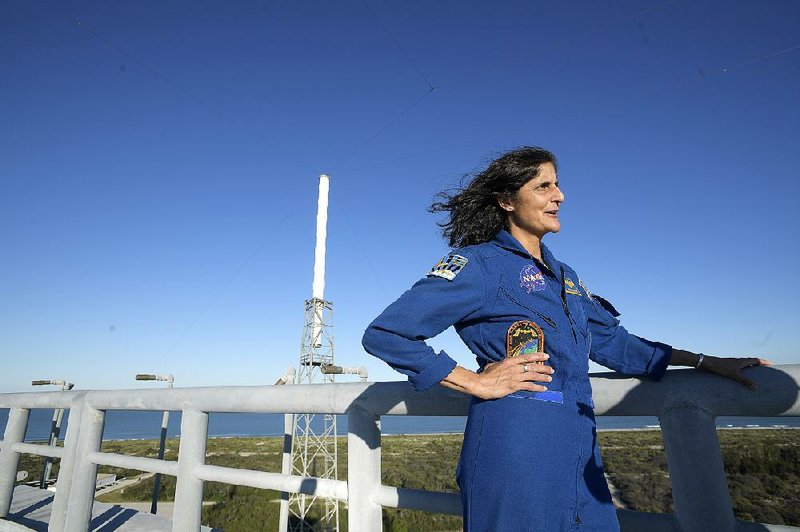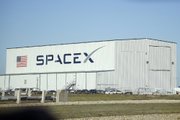CAPE CANAVERAL, Fla. -- They will take the elevator 175 feet above the shoreline, then march 15 steps across the platform and another 13 down the grated gangplank to the double doors that open to a small white room.
There the astronauts will make their final preparations, adjust their spacesuits and check their equipment before stepping into the spacecraft.
This is the walk the astronauts will take as part of NASA's effort to return human spaceflight to U.S. soil by 2018, ending a hiatus stretching from 2011 when the space shuttle was retired.
Now, NASA is depending on two commercial companies -- Boeing and SpaceX -- to ferry its astronauts to the International Space Station, under contracts worth billions.
Both companies have faced technical and design challenges that have forced them to push back the dates of their initial flights -- delays that could prove costly.
But there are growing signs that the companies are making progress. Last week Boeing opened some of its new facilities in Florida for the first time and unveiled its new spacesuit, offering a glimpse of what's to come.
The new crew tower at Launch Complex 41, the last place on Earth the astronauts will travel before stepping into the company's Starliner spacecraft, is one example of the company's progress. It's a hulking structure, made of 1.4 million pounds of steel, that adds yet another point to the cape's skyline and offers a penthouselike view of the shoreline.
Boeing has also built a new mission-control room at the Kennedy Space Center, with rows of computer consoles that will one day monitor the rocket's health, its avionics and communications, and its fuel and navigation systems.
Then there's the new sleek and blue Boeing spacesuit that, at 20 pounds, is 10 pounds lighter than the one worn by shuttle astronauts. It comes with gloves that work on touch screens and light-weight boots designed by Reebok that feel like slippers. Instead of having a fishbowl bubble helmet, as the shuttle astronauts did, the new suit's helmet slips over the head like a hood.
"We like to think this represents the future of what protective space gear will be," said Chris Ferguson, a former NASA astronaut who is now Boeing's director of crew and mission systems.
Because it's so lightweight and flexible, the former Navy fighter pilot said, "it feels a lot more like a flight suit than a spacesuit."
Elon Musk's SpaceX is designing its own suit, which it has not yet unveiled. But just across the cape, SpaceX has made visible progress with its new launch site, the historic pad 39A, which was used during the Apollo and shuttle eras.
That launch site, which years ago was rusting away in the salt air, has been renovated. Nearby, the company has built a hangar for its rockets that has the SpaceX logo emblazoned across it -- a potent symbol that the private sector is putting its stamp on the venerable government facility.
SpaceX plans to christen the pad within days, launching the first rocket from 39A since the final shuttle mission some six years ago.
The work by SpaceX and Boeing is part of a broader effort to transform Cape Canaveral from an area once dominated by the government to what NASA calls a "multiuser spaceport" that is home to several commercial companies.
Jeffrey Bezos' Blue Origin is also leasing a launch site there. The company is building a 750,000-square-foot facility where it wants to build its New Glenn rocket, which it plans to fly by the end of the decade. (Bezos is the founder of Amazon.com and owns The Washington Post.)
Moon Express, which is vying to land a spacecraft on the moon as part of the Google Lunar X Prize, has also had a partnership with NASA to test its lunar lander at the Kennedy Space Center.
But nothing will represent the cape's renaissance more than the return of human spaceflight. Boeing and SpaceX are competing to see which company will fly first. SpaceX says its first test flight with passengers on board is scheduled for May 2018. Boeing plans to make its first uncrewed flight in June 2018, with a two-person test flight in December of that year.
Both companies, however, have faced delays that NASA's inspector general's office warned last year could force NASA to buy more seats from the Russians, who now take U.S. astronauts to the space station. The inspector general found that the cost Russia charged to ferry U.S. astronauts jumped 284 percent over the past decade, growing from $21.3 million in 2006 to $81.9 million last year.
In its report, the watchdog said it believed that neither company would "achieve certified, crewed flight to the ISS until late 2018."
In the past, funding shortfalls led to the delays, the inspector general's office said. But "technical challenges with the contractors' spacecraft designs are now driving the schedule slippages," it said.
Boeing's spacecraft, the Starliner, has had problems with its mass and the effects of vibrations during launch. SpaceX's delays cropped up when it changed its capsule design to land in the water instead of on land, it said.
Boeing's Ferguson said "turning from the design effort to the manufacturing effort became more of a challenge than we anticipated."
The company has "slogged through some of the real engineering challenges, and now we are getting to the point where those challenges are largely behind us and it's time to get on to the rubber meeting the road," he said.
Sunita Williams, one of four NASA astronauts chosen to fly on the first commercial flights, said she is "pumped" by the prospect of launching again from American soil. "We're getting closer and closer," she said.
But she acknowledged that the companies still have "a long road, and they have a lot to do. But I am really encouraged and excited at the pace at which both companies are taking this challenge .... Things are ticking along. It's going to happen."
SundayMonday on 01/29/2017

